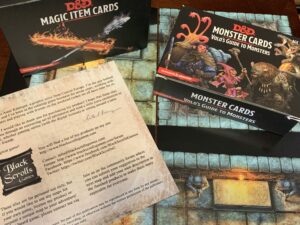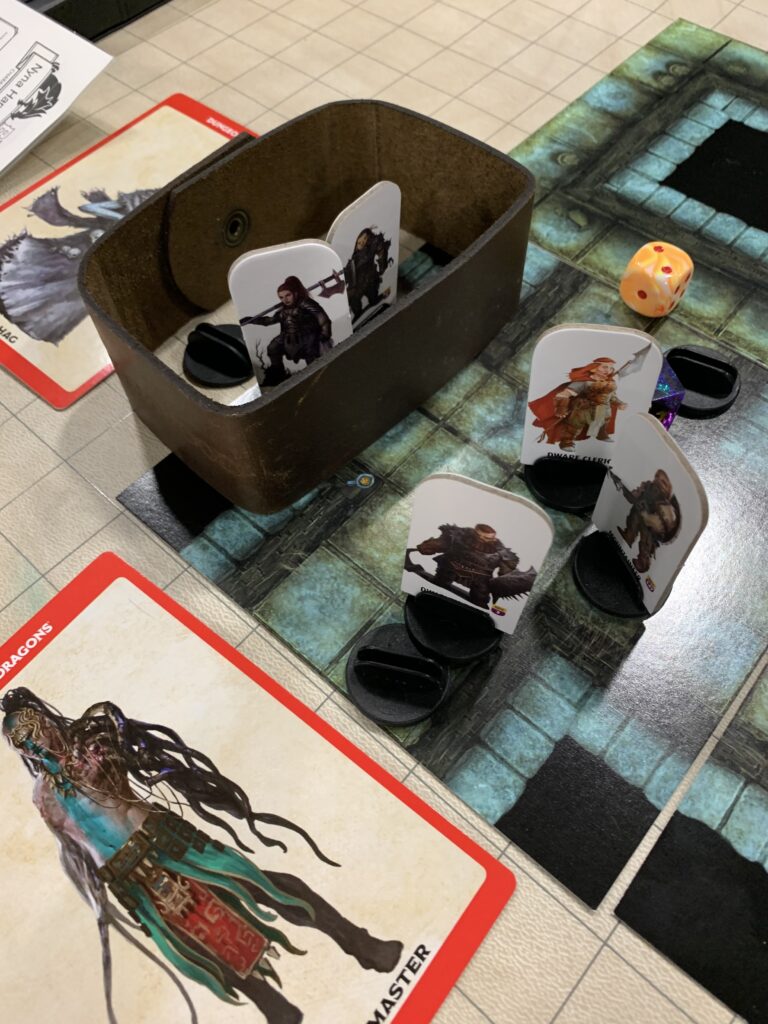Building and Running The Cursed Citadel DnD 5th Edition
Posted on October 24, 2023 by Monica Valentinelli
To celebrate GameHole Con’s 10-year anniversary, I opted to run a collaborative DnD 5E scenario. I ran the scenario four times, and by the fourth time I ran it–thanks to over 20 players’ feedback–it turned into something that I’m proud to share with you to celebrate Halloween.
The conceit behind The Cursed Citadel is simple: you play a group of level five mountain dwarves who dug too greedily and too deep. When the scenario opens, you can only see one tile of the dungeon you’re in–even with darkvision. An ancient, unknowable god of the mountain speaks in a booming voice, relaying that you’re cursed to never die.
Act I: Tendrils of Doom
In the first act (or first hour), when you explore the dungeon you roll a D20 (CR 10). Succeed? You, as the player, builds the dungeon by choosing a random tile. Fail, and a random monster appears. Yes, you heard me right: players pull a random monster from a deck.
Since this is a scenario without milestones or XP, the player who defeats the monster receives a random magic item. I ignored attunement in favor of giving players the ability to use something cool during this continuous battle. Classes, however, did matter and players could swap an item with another player by rolling another d20 (CR 12).
By the end of Act I, the dwarves discover what “not dying” means: they turn undead when their HP reach zero. Fire does double damage, necrotic damage heals them, and regular healing spells damage them. Should they be attacked by a random creature who successfully affect their minds, they become one of the mindless undead who acts on instinct and must eat a brain to restore their consciousness.
To reflect the horror of a party member turning undead, the cleric, druid, and paladin in the group roll a Wisdom Saving Throw. The target number is the undead dwarf’s Wisdom. A failure means that party member is, for one round, considered a monster, too.
Act II: A Curse Unfolds
In the second act, the players choose whether to “double” the monsters or pick a new monster. Initially, doubling the monsters created a mirror image: a shared HP pool, but used double attacks. By the last game, one of the players concocted a better solution–additional heads spring from the same monster reflecting the double attack. The CR is increased to 15 to reflect the mountain god’s unhappiness. In Act II, the players also learn what “too deep” means–they have descended into the rocky head of the mountain god who stands deep, deep into the earth.
At this point in the adventure, the players are a mixture of undead and living dwarves. Toward the end of Act II, at least one of the undead reaches HP zero again and becomes a ghost. In this state, the ghost cannot wield or pick up new items. They can, however, wield their existing weapons to cause necrotic damage.
Ghosts are affected by psychic damage and can now possess other undead or living creatures on the board–including the monsters. To possess a monster, the ghost dwarf makes an attack roll as they normally would and needs to meet or beat the monster’s AC. Once inside the monster, the body is affected by damage and can die–which ejects the ghost and transforms them back into a mortal dwarf with their HP restored. This both thematically and mechanically concludes the curse’s effects.
Act III: Beseeching an Ancient God
Act III proceeds as ghost-possessed monsters chip into the fight, but resolves when a specific dungeon tile is placed and the players reach the altar to beg for atonement. I tested whether or not the players could draw the tile and realized that placing the tile half an hour into Act III worked best. When I added the tile, the players knew they had to reach the altar.
To close the scenario, the mountain god asks each player what they will do to repent. Each dwarf makes an offering to the mountain god, no matter the state of their character, and uses their Persuasion Skill (CR 12). If they profess they’ll prevent or warn others from digging too deeply, the mountain god tells them to narrate another dwarf’s punishment. Some dwarves remained inside the mountain god to warn other adventurers; others were freed–no two dwarves appeased the mountain god the same way.
Feedback and Adjustments
The feedback I received from this scenario yielded additional suggestions and feedback. Most players liked the random monsters, building the dungeon, and reaping rewards–and loved the change from mortal to undead to ghost and back again. All the dungeons were small–only four-or-five tiles–which reflects both roll results and the nature of combat. The players understood, up front, that death was an option that didn’t stop the game. By doing that, they took more risks and didn’t stop to heal, because they wanted to see what happened.
 I used map tiles from Black Scroll Games and cardstock minis from Paizo Publishing to accessorize the core Dungeons & Dragons materials. In addition to monster cards from Volo’s Guide to Monsters, magic item cards, and the core rules, I built the characters on DnD Beyond. Unfortunately, DnD Beyond character builds weren’t as ideal as they’d been in the past, and that meant I allotted for 15-to-20 minutes worth of prep to give players a chance to add personal touches.
I used map tiles from Black Scroll Games and cardstock minis from Paizo Publishing to accessorize the core Dungeons & Dragons materials. In addition to monster cards from Volo’s Guide to Monsters, magic item cards, and the core rules, I built the characters on DnD Beyond. Unfortunately, DnD Beyond character builds weren’t as ideal as they’d been in the past, and that meant I allotted for 15-to-20 minutes worth of prep to give players a chance to add personal touches.
I had used DnD Beyond several times in the past, but since moving to a subscription model my free version doesn’t seem as comprehensive as its previous iteration. Options were either limited or didn’t apply to the final character–armor, for example, had to be applied and I realized that error too late. If I had to build characters again, for a published scenario or to run at another convention, I’d use a manual option to ensure they didn’t require further customization and…well…make sure my printer was working a week or two before the show. (Much embarrassment… Though in my defense, paid deadlines took priority.) I did feel the customization required at the table allowed the players to have some “say” in the shape of their pregenerated characters, however, and that helped build investment in the scenario. Keeping a bit of prep makes sense for a scenario like this, because otherwise it’s just a character that might perish and there’s no emotional payoff.
Closing Thoughts
The random elements are a departure from many planned adventures–including my own. This time, I opted to incorporate them to help empower players, test new conditions, and make them feel more comfortable at a con. I also feel, quite strongly, that you can run a horror game using the existing Dungeons & Dragons 5th Edition rules without making significant modifications.
To help ease anxious players, I let them manage the monsters I physically couldn’t reach across the table, and encouraged them to collaborate when players couldn’t remember the rules or didn’t know what dice to roll. In that spirit, I perceived my role as the facilitator of a fun and spooky experience, running a game not just for a group of strangers, but with them. Though a collaborative style may not be for everyone, I’m happy to say that we had a great time and folks were encouraged to provide feedback that shaped the next group’s experience in the best way possible.
If I were to run this again, I would keep the random elements but limit the options within a more targeted pool for the tiles, monsters, and magic items. The Cursed Citadel does have a limited life span–this is a great one-shot perfect for a convention or as a drop-in for a campaign–but has the potential for a deeper story. Instead of simply “digging too deep”, for example, the players could discover other adventurers trapped in the mountain god and rescue them. Alternatively, some of the magic items could be discovered on random tiles, as well, to increase their flow and usage.
New! Conditions!
If you’d like to include the playable option for undead or ghost in your D&D adventure, I’ve written them up as conditions–just in time for Halloween! Should you decide that the curse doesn’t work for your games, my suggestion is to make the conditions temporary and last for 1d8 rounds or resolved by a specific trigger of your choosing.
Undead
* An undead character is no longer healed by normal spells and potions.
* Necrotic damage heals an undead character.
* Any spells that affect the undead also affect characters within range.
* Fire damage from traps, spells, attacks do double damage.
* Once an undead character’s HP drops to zero, they become a ghost.
* Should an undead character’s mind be affected, they become undead (mindless).
Undead (Mindless)
* An undead mindless character acts on instinct and attacks whatever (or whomever) is within the closest proximity.
* An undead mindless character can restore their mind by eating the brain of any creature.
* Should an undead (mindless) creature’s HP drop to zero, they become a ghost (mindless).
Ghost
* A ghost character can only suffer from Psychic damage.
* Ghosts can wield the weapons, magic items, and equipment they did in life. When they attack, they cause necrotic damage on living and undead creatures when not possessing a body.
* Ghosts can possess any living or undead creature with a body. To do so, the ghost makes a normal attack roll and must meet or exceed the target’s AC. Targets must make a WIS saving throw to survive possession each round. On a failed save, the ghost retains the body. On a success, the ghost is ejected and suffers 2d8 Psychic damage.
* Once a possessed body dies, the ghost is ejected and returns to its prior, mortal form.
* Once a ghost’s HP drops to zero, that character returns to its previous, or undead, state**.
Ghost (Mindless)
* A mindless ghost seeks to possess the nearest creature.
* The mindless ghost can restore its consciousness when it successfully possesses another character. (e.g. not a monster)
* Once a ghost’s HP drops to zero, that character returns to its undead state.
** Please note: The cycle of conditions was a special aspect of the curse designed for this scenario. You may decide to make further adjustments that better fit for your haunted locales or style. You may also decide to adapt the undead and ghost rules from monsters to ensure they apply whole cloth to characters, too.
This post does contain some affiliate links to Amazon, for I am an undead creator who subsists on caffeine and whatever else I can conjure–like toads! For OcTOADber…


